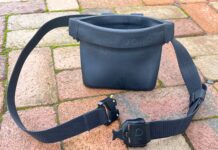Try to remember that you have to help your dog understand your cues.
I was volunteering at the shelter last Saturday, and in the course of the day, I showed several dogs and puppies to several different potential adopters. It struck me at some point that almost every person who takes a strange dog or pup out into a “get acquainted” room or grassy run will almost immediately tell the dog (or pup!) to “Sit! Sit! SIT! Siiiiiitt?” It’s as if they always assume the canine knows what “sit” means and is being willful in not responding.
It’s SO difficult for people to understand that dogs don’t know what we’re saying – and it speaks to our comfort and familiarity with them that we wouldn’t expect a chicken or a turtle or a camel to “Sit! Sit! SIT!” upon hearing the words. You wouldn’t approach a person in Laos and say, “Excuse me, can you tell me what time it is?” And yet, just about everyone seems to expect EVERY dog or puppy to instinctively understand and respond to spoken English.
What if someone – a human, or an animal of another species, even! — approached you and began barking, “Fwick! Fwick! FWICK!” and then appeared to get sort of angry because you just looked at them puzzled? Would you want to continue to try to figure out what this other animal wanted? *I* wouldn’t!
Most modern trainers know that the fastest, easiest way to teach a dog (or other animal) to perform a behavior on cue is to:
1. Figure out how to elicit the behavior (or “catch” the animal doing it) and immediately reward the animal with something significantly enjoyable (treat, toy, praise, petting . . . anything as long as it’s demonstrably enjoyable.
2. Start using the desired cue for the behavior at the same time the animal performs the behavior.
3. Then, start using the cue FIRST, and then waiting for a few seconds, to see if the animal makes the connection between the cue and the desired behavior.
This approach doesn’t assume that the animal can understand English or is hard of hearing. This is a systematic approach that builds a behavior in a certain fashion – and you’d be amazed at how fast dogs will learn new behaviors once they learn the pattern of new behavior acquisition. After they’ve learned two or three behaviors that you have built the same way – elicit, reward; pair with a cue, reward; use cue first, wait, reward – they are eager to “offer” new behaviors, in hopes of finding more and new ways to get you to reward them, and they pay keener attention to anything you are doing that may turn out to be a cue. Because cues turn into “shortcuts” – or early clues as to the behavior you’re waiting to reward.
As soon as you can reliably elicit the behavior from the animal, start using the word, sound, or gesture that you want to be the cue for the behavior at the same time the animal performs the behavior. Remember, it’s NOT a “cue” yet; at this point, it’s just something the animal will begin to associate with the behavior (and the resulting reward). You are simply pairing the signal with the behavior, so the animal will begin to associate the signal with the behavior. That’s all! So don’t repeat yourself or say it louder if you don’t get a response.)
Then, start using the cue FIRST, and then waiting for a few seconds, to see if the animal makes the connection between the cue and the desired behavior. Use the cue just ONCE, and WAIT for a few seconds. You should see the wheels start to spin in the dog’s head. “Why is he looking at me? What does he want? How can I get him to give me the treat THIS time?” If, in the early stages, the dog guesses right, and does the behavior from the cue alone (as opposed to doing it in response to whatever you were doing to elicit it before, such as using a food lure or positioning your body in a certain way (such as leaning in toward the dog to get him to lean backward into a sit), then reward him with a nice jackpot of treats.
But what if he doesn’t respond to the signal that you want to be the cue or “command” for the behavior? Don’t panic. He just hasn’t made the connection yet. Give the cue – once – and wait a few seconds, then elicit the behavior as you were before, and as he does the behavior, at the SAME TIME, use the cue again. Do this a few times before trying again with the cue first.
It should be obvious that untrained dogs don’t know what “Sit!” means – so it’s pointless to say it, repeat it, or shout it at them.
But what if your “trained” dog, who “knows what ‘Sit!’ means!” behaves as if she DIDN’T know what it means? It’s likely that you are giving her the cue in a context that she isn’t familiar with, or in the face of more distrations than she can handle. Think about it like this: You’ve taught a kindergartner how to add one plus one and other very simple math problems. Could she complete them in the middle of a street fair? Could she tell you the answer quickly if she was riding a tricycle at the same time? She probably could – with practice. If you want your dog to be able to respond properly to the “Sit!” cue when you are out on walks, for example, you have to start practicing (with rewards!) on small, quiet walks, and slowly build up to practicing on walks in distracting, hectic, loud environments. If you want your dog to be able to respond with a sit as a barely-restrained leash-aggressive dog goes by, or when an ambulance is going by with the siren on, you have to practice in those environments! Because as much as we like to think otherwise, dogs do NOT understand our speech and desires in the way we understand other English-speaking humans.





